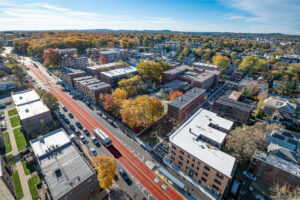
Columbus Avenue’s bus lanes are the first center-running bus lane facility in the MBTA service area and in New England. Photo courtesy of the MBTA
Staffing woes last year made the MBTA put the brakes on an ambitious plan to revamp its bus network into a more reliable and frequent companion to the subway system. But what appears to be the runaway success of the T’s hiring efforts has put the idea back on the table.
MBTA staff told the agency’s board Tuesday that parts of the transformed bus network would start to roll out towards the end of next year. The result, T officials say, will condense many sometimes-convoluted and infrequent bus lines into a smaller number of simpler routes that come at least once every 15 minutes, and sometimes as little as every few minutes, seven days a week – similar to subway service. Routes will also be shifted to cover emerging job centers and growing nodes of real estate development, and some will be extended to better cover existing job centers like the Longwood Medical Area and cities like Chelsea and Everett that have limited transit service today.
“We are so excited for Bus Network Redesign because it’s a growth plan. We already have a lot of people riding the bus and this is a way to get more of them,” Senior Director of Bus Transformation Justin Antos told the board. “This is a bus that you can rely on. In fact, we hope folks don’t have to rely on a bus. They can just show up.”
The new routes and enhanced service will need substantial numbers of hires, though, forcing it to be shelved until recently. Staff credited a new contract the Healey administration negotiated with the transit operators union this summer for being able to restart the plan. The contract turned the T’s bus drivers from some of the worst-paid in the nation to the best, and added a $7,500 signing bonus and commercial driver’s license training for new hires.
The T previously released figures showing had hired 1,029 new workers through Oct. 4, for a net increase of 438, to fill the hundreds of vacant posts created by early retirements and a hiring freeze during the COVID-19 pandemic, plus years of under-funding that left staffers covering multiple functions. That’s up from a 112-person net loss in 2021 and a 166-person net increase in 2022.
Federal safety investigators said this spring that the T likely needs to add up to 2,000 net new workers above its late 2022 headcount to fix its staffing problems, from operators and maintainers to administrators and safety workers.
In addition to more drivers, T officials said the transformed bus routes will need local officials in Boston, Brookline, Chelsea, Everett, Medford, Newton, Somerville, Cambridge and Revere to revamp the local streets those routes use.
Antos presented the board with a map of streets that local officials have already or are in the process of modifying to speed buses along with tools like dedicated lanes, mechanisms to give buses priority at traffic lights or enhanced bus stops with shelters, lighting and automated signs that display when the next bus arrives. Also on the map: streets where the T says it needs towns and cities to add or extend that work starting next year.
Officials separately released a detailed package of statistics to argue their case for prioritizing bus travel and tools local officials can use to make it happen.
“We targeted places today where buses are stuck in traffic, moving slowly and unreliably and full of bus riders,” Antos said, adding that the changes could make trips faster and more reliable for up to 80 percent of bus riders.
Previous bus lanes have occasionally proven controversial, requiring substantial public engagement to construct, but some municipal leaders have also launched the bus lanes as pilot projects that later transformed into permanent parts of the road after proving successful.




 |
| 

